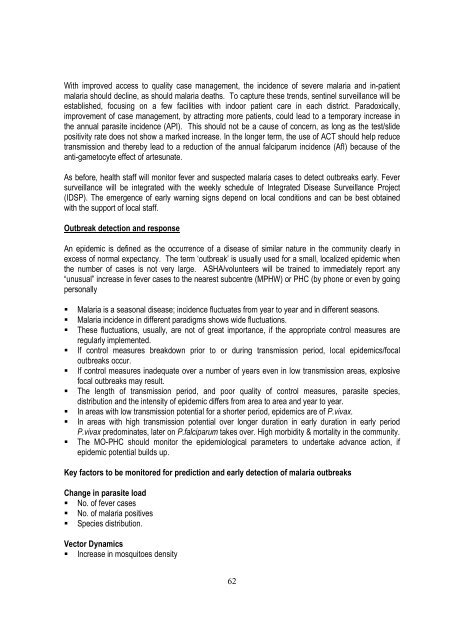training module for medical officers primary health centre - NVBDCP
training module for medical officers primary health centre - NVBDCP
training module for medical officers primary health centre - NVBDCP
- No tags were found...
You also want an ePaper? Increase the reach of your titles
YUMPU automatically turns print PDFs into web optimized ePapers that Google loves.
With improved access to quality case management, the incidence of severe malaria and in-patientmalaria should decline, as should malaria deaths. To capture these trends, sentinel surveillance will beestablished, focusing on a few facilities with indoor patient care in each district. Paradoxically,improvement of case management, by attracting more patients, could lead to a temporary increase inthe annual parasite incidence (API). This should not be a cause of concern, as long as the test/slidepositivity rate does not show a marked increase. In the longer term, the use of ACT should help reducetransmission and thereby lead to a reduction of the annual falciparum incidence (AfI) because of theanti-gametocyte effect of artesunate.As be<strong>for</strong>e, <strong>health</strong> staff will monitor fever and suspected malaria cases to detect outbreaks early. Feversurveillance will be integrated with the weekly schedule of Integrated Disease Surveillance Project(IDSP). The emergence of early warning signs depend on local conditions and can be best obtainedwith the support of local staff.Outbreak detection and responseAn epidemic is defined as the occurrence of a disease of similar nature in the community clearly inexcess of normal expectancy. The term ‘outbreak’ is usually used <strong>for</strong> a small, localized epidemic whenthe number of cases is not very large. ASHA/volunteers will be trained to immediately report any“unusual” increase in fever cases to the nearest sub<strong>centre</strong> (MPHW) or PHC (by phone or even by goingpersonallyMalaria is a seasonal disease; incidence fluctuates from year to year and in different seasons.Malaria incidence in different paradigms shows wide fluctuations.These fluctuations, usually, are not of great importance, if the appropriate control measures areregularly implemented.If control measures breakdown prior to or during transmission period, local epidemics/focaloutbreaks occur.If control measures inadequate over a number of years even in low transmission areas, explosivefocal outbreaks may result.The length of transmission period, and poor quality of control measures, parasite species,distribution and the intensity of epidemic differs from area to area and year to year.In areas with low transmission potential <strong>for</strong> a shorter period, epidemics are of P.vivax.In areas with high transmission potential over longer duration in early duration in early periodP.vivax predominates, later on P.falciparum takes over. High morbidity & mortality in the community.The MO-PHC should monitor the epidemiological parameters to undertake advance action, ifepidemic potential builds up.Key factors to be monitored <strong>for</strong> prediction and early detection of malaria outbreaksChange in parasite load No. of fever cases No. of malaria positives Species distribution.Vector Dynamics Increase in mosquitoes density62
















